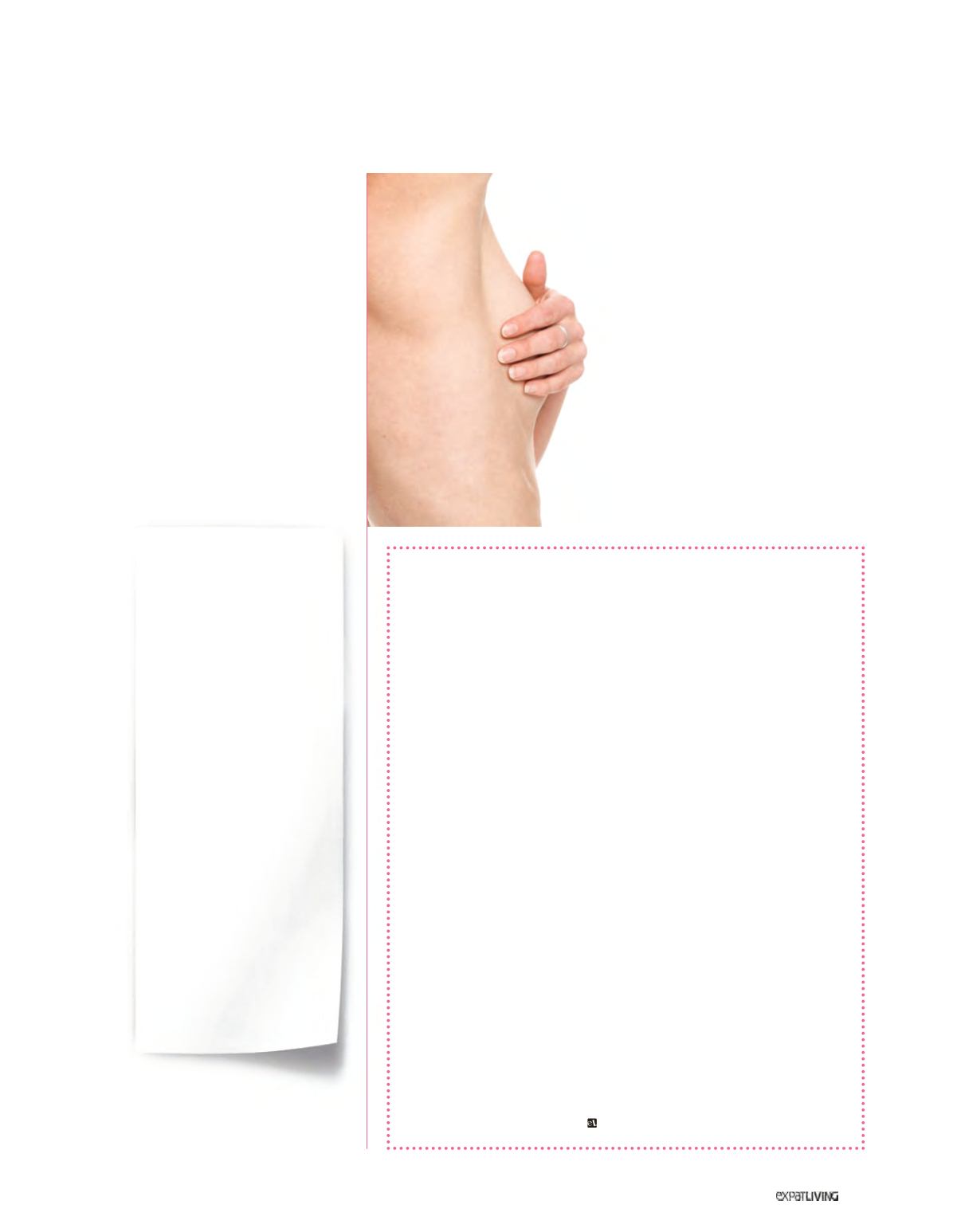

BREAST CANCER AWARENESS
303
October14
What preventative steps, if
any, can be taken?
Maintain a healthy weight and
lifestyle, limit alcohol consumption
and avoid overexposure to long-term
hormonal therapies; women can go
on HRT to relieve their menopausal
symptoms, as long as it’s for less
than five years. Those women
with a very strong family history
of breast cancer who have tested
positive for the breast cancer gene
mutation may choose to undergo a
prophylactic mastectomy; they may
also choose to have their healthy
ovaries removed (prophylactic
oophorectomy) to reduce the
risk of both breast and ovarian
cancers once they have reached
menopause.
Dr Ng recommends that, in
addition to breast screenings,
women should have a
general screening once a
year for peace of mind, and
for the early prevention or
detection of any diseases.
His clinic offers a GynaeMD
Pelvis, Breast and Bone
Package for women 40
and above, and for those
who are menopausal; the
package involves a pelvis
ultrasound, mammogram
and blood cancer markers,
and an evaluation of bone
mass density. According to
Dr Ng, this examination is
very beneficial in that it allows
for any benign breast lumps
or cysts to be observed;
if they appear suspicious,
they can be removed or the
patient can be referred to a
breast surgeon for a second
opinion; similarly, any fibroids
and cysts that are discovered
can be monitored.
GynaeMD Women’s and
Rejuvenation Clinic
1 Orchard Boulevard, #04-03A
Camden Medical Centre
6733 8810 | gynaemd.com.sg
The Stats
•
According to World Cancer Research Fund International, breast cancer
is the most common cause of cancer-related deaths among women
globally, with more than 450,000 deaths each year, and accounting for
about 14 percent of all female cancer deaths.
•
According to the Health Promotion Board, breast cancer is the most
common cancer among Singaporean women.
•
Breast cancer is themost commonly diagnosed cancer among Australian
women, according to the National Breast Cancer Foundation in Australia.
It’s estimated that, in 2014 alone, 15,270 women in Australia will be
diagnosed with the disease.
•
According to Cancer Research UK, the lifetime risk of being diagnosed
with breast cancer is one in eight for women in the UK, where it’s the
most common form of cancer. The same goes for women in the US, says
the American Cancer Society (ACS).
•
The ACS projects that around 232,670 new cases of invasive breast
cancer will be diagnosed in the US this year, and about 62,570 new cases
of carcinoma in situ (the earliest form of breast cancer) will be detected;
sadly, an estimated 40,000 women will die this year from the disease in
the US.
•
Although breast cancer is often thought to be a disease of the developed
world, almost 50 percent of breast cancer cases and 58 percent of
deaths occur in less developed countries, according to the World Health
Organisation (WHO).
•
In 2012, Belgium had the highest incidence of breast cancer, followed
by Denmark, France and The Netherlands, according to World Cancer
Research Fund International.
•
According to WHO, breast cancer survival rates vary greatly worldwide,
ranging from 80 percent or more in North America, Sweden and Japan,
to around 60 percent in middle-income countries and below 40 percent in
low-income countries, mainly due to a lack of early detection programmes
in less advanced countries.
Check Yourself
Whether or not women should do breast
self-exams has become a subject of debate
in recent years, as the issue of accuracy
has been called into question. However, one
thing’s for sure: the more aware of your body
you are, the more likely you are to notice if
something’s out of the ordinary, and potentially
harmful. It’s important to know how your
breasts normally look and feel, and being in
the habit of checking for any abnormalities
can be a valuable means of keeping tabs
on your breast health, even if you do visit the
doctor for regular exams. According to John
Hopkins Medicine, 40 percent of diagnosed
breast cancers are detected by women who
feel a lump, so establishing a regular breast
self-exam routine is crucial. For a step-by-step
guide to conducting a breast self-exam, visit
www.breastcancer.org.



















